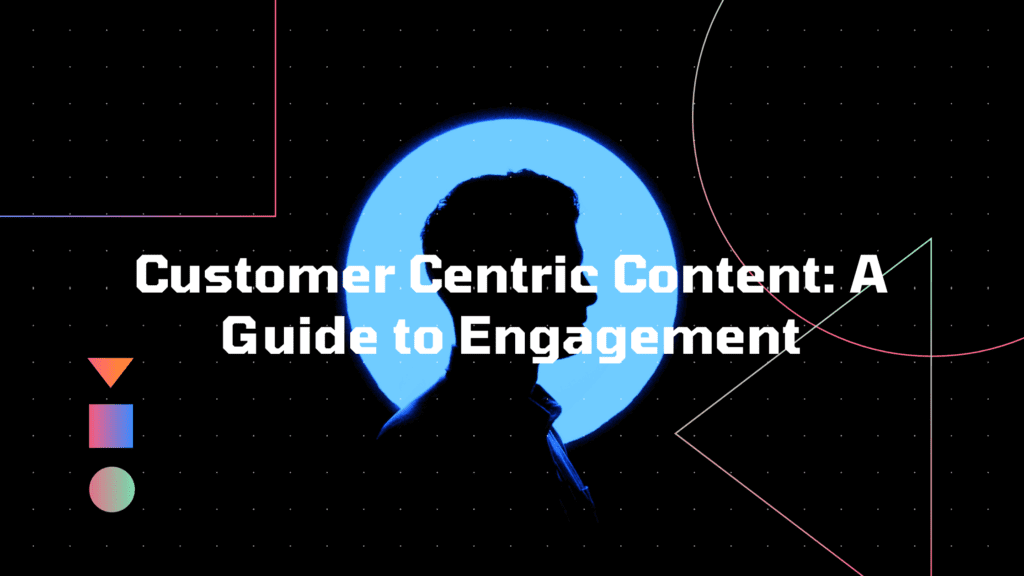People don’t care about how great you are, they want to know what problems you solve. Conveying the right messaging on your website can be the difference between a new lead and a bounce.
Have you ever started watching a YouTube clip and found yourself jumping to the 1:00 mark to skip the preamble? That’s the exact experience people have with the average website, too. Most sites start with generic sales points, claiming they’re the best, the cheapest or most powerful, using their website to do a lot of talking without saying anything of value to the customer. They’re self-centered not centred on the customer.The best way to engage your audience is by writing customer-centric content delivering what they’re looking for, not what you want them to know. So here’s how to turn that messaging around:1. Identify your audience clearly
To effectively deliver what your audience is looking for, you first need to understand who they are. You do that by asking the right people all the right questions.To truly understand your audience, you’ll need to know:- What problem are they trying to solve?
- What are their core motivations for using your product?
- Where are they looking?
- Do they work in an established entity or a new brand?
- Are they educated on the type of product you sell or do they need education?
- Are they seeking education on the topic or do you need to find them?
- What are the biggest roadblocks to them coming on board as a new client?
- Speak to your sales team — they talk to new clients every day of the week. They’ll be able to answer most of these questions straight away
- Send your existing customers a simple survey that covers these questions
- Check Google Search Console to see what relevant queries are being asked (more on this below)
2. Determine what they’re actually looking for
For this exercise, the usual demographic details are irrelevant. The only thing we care about is answering the question “When someone visits our website, what exactly are they trying to find?” Go beyond lazy answers like “the best price” or “the best platform” and answer the question properly. What are they really trying to find?For example, price may be a factor but what they might really be looking for is a tool that takes repetitive, menial tasks off their plate so they can focus on important things. Maybe they need a platform with better reporting for those monthly meetings. It could even be that they’re using one of your competitors but they need something that integrates with Quickbooks.Knowing how to accurately answer that question is difficult, so here are a few places to check:Look at your long-tail keywords
You already know your target keywords but when was the last time you thought about what those phrases represent? Looking at one of our clients, for example, broad keywords like “cannabis software” don’t give us many clues. It’s when you start to dig into those longtail terms that we can start to get a clearer picture.For example, “how to start an edibles business” and “daily cycle counts and reconciliation of inventory variances” both give us different sets of clues around search intent. While the first one is clearly in the planning phase of a new business, the other is very specific and uses more advanced terminology.Before we get into what you can do with this information, let’s go over the three best places to find this info for your brand.Check Google Search Console (GSC)
Click Search Results on the left side and you’ll be presented with a sea of data about your website’s performance in Google Search. We’re interested in the table at the bottom. This table is a list of keywords people have actually used to find your product (or competitor product, if they didn’t click on your site).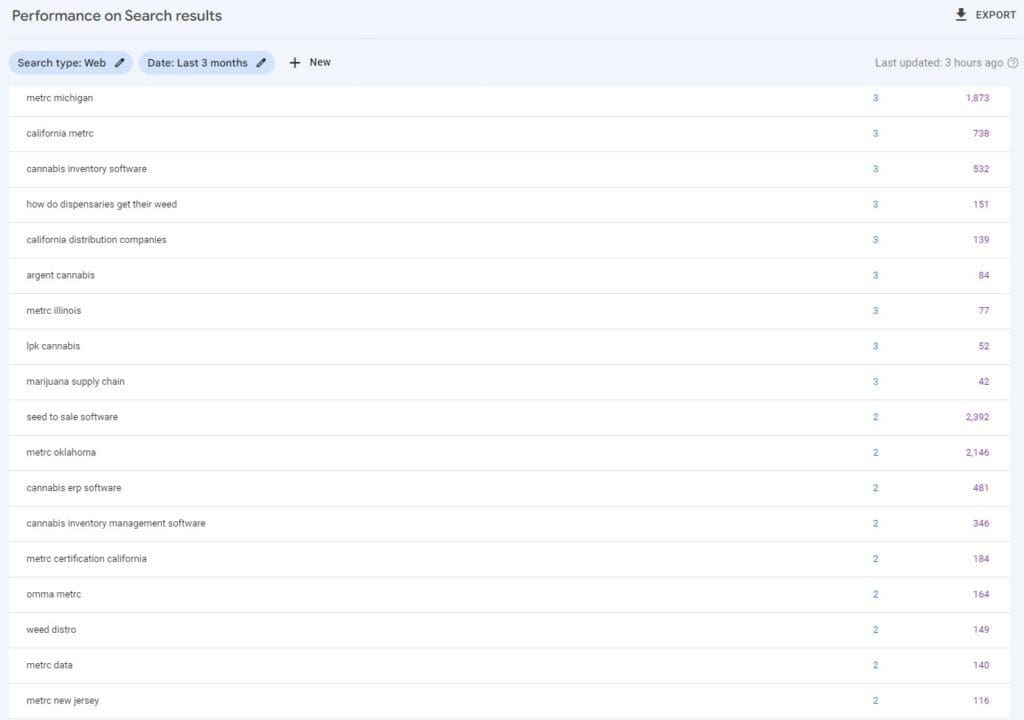 Make your way through this list of search queries, thinking about the intent of that search. Compare this against the ideal audience you’ve identified from above.Sticking with the example from above, their ideal audience is an established brand in the industry — new entities aren’t a good fit for them so someone searching “how to start an edible business” is not on their radar. “Daily cycle counts and reconciliation of inventory variances”, however, is. Their software and integrations mean they do an excellent job of delivering the very specific thing that almost 120 people are looking for every month.Knowing the industry and looking at the language used in this search, we can infer that:
Make your way through this list of search queries, thinking about the intent of that search. Compare this against the ideal audience you’ve identified from above.Sticking with the example from above, their ideal audience is an established brand in the industry — new entities aren’t a good fit for them so someone searching “how to start an edible business” is not on their radar. “Daily cycle counts and reconciliation of inventory variances”, however, is. Their software and integrations mean they do an excellent job of delivering the very specific thing that almost 120 people are looking for every month.Knowing the industry and looking at the language used in this search, we can infer that:- They’re an established brand in the industry The fact they’re using industry terminology and seeking better efficiency indicates that they’re already set up and trying to improve what they have. New brands are generally trying to solve more rudimentary problems.
- They’re already using the mandated software platforms at the very least Cycle counts form part of mandatory compliance requirements in the US cannabis industry. Another signal that they’re trying to improve their existing processes rather than forging new ones.
- They understand why a template and integration would be helpful Inventory reconciliation is a time-consuming part of compliance in the industry — a frustration all operators deal with. They don’t need to be sold on the fact that a more efficient process here would save them a lot of time and stress.
- They’re actively seeking the solution this client provides Since they’ve gone out of their way to complete this Google search, they’re actively looking to solve this problem right now. They’re looking for the solution this client provides.
Ahrefs or SEMrush
Both of these tools are ideal for seeing what your competitors are up to, among other things. Since you’ve already pulled your own data from GSC, it’s time to snoop around in your competitors’ keywords as well.In Ahrefs, type your competitors’ URLs into Site Explorer, then click Organic Keywords on the left. Just like the GSC keyword list, you’ll see all the terms they rank for.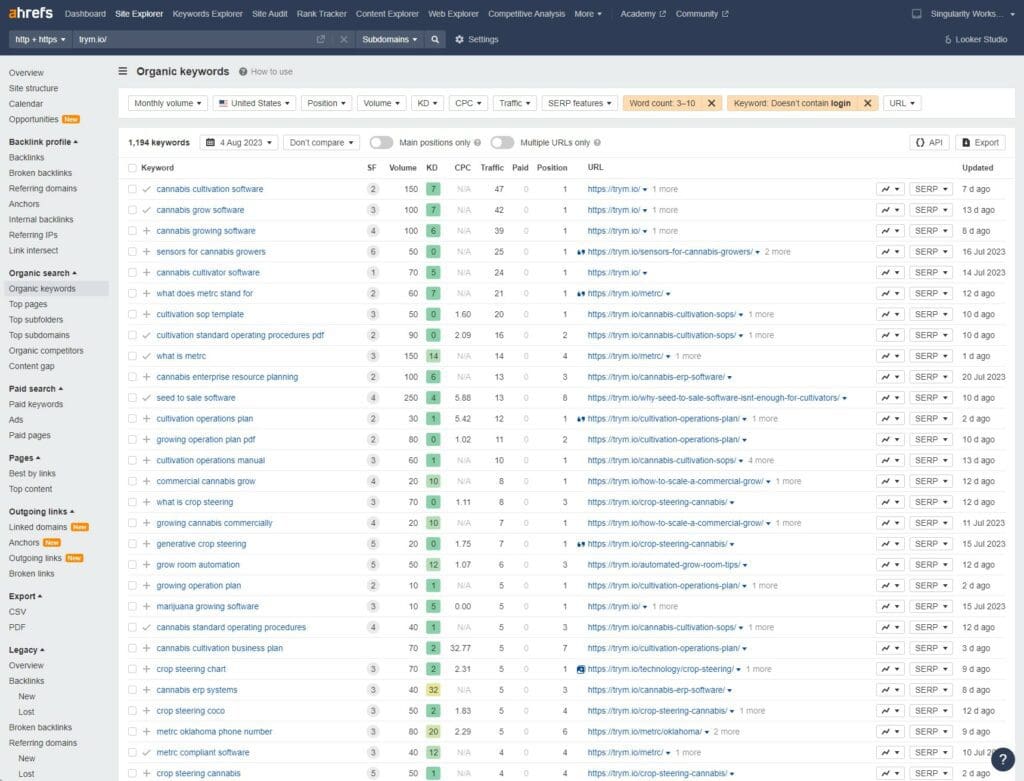 Make use of filters here to reduce the time spent looking through these keywords. The two I’ve used here, visible in the top bar:
Make use of filters here to reduce the time spent looking through these keywords. The two I’ve used here, visible in the top bar:- Word Count: 3 – 10: This shows you keyword phrases that contain 3 to 10 words. Phrases with 1 or 2 keywords will be too top-level to be helpful and anything with 10+ words is typically gibberish.
- Keyword Doesn’t Contain: In this instance, there are a lot of searches for various login terms like ‘metrc login’. These terms aren’t relevant or helpful so filter them out.
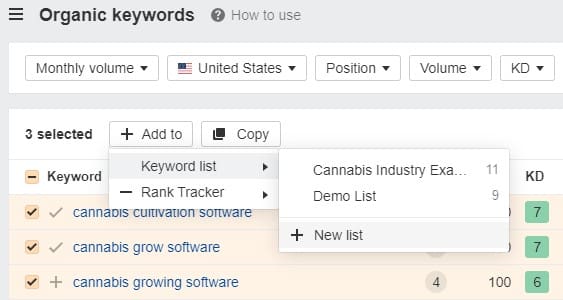
To add keywords to a list, click the checkbox on the left, then click Add to > Keyword List > New List.
Once you have those keywords saved to a list, you can view it by clicking Keyword Explorer in the top navigation and selecting your list at the bottom. By clicking this list, you can see all the terms you added, along with a visual of the dominant themes. This visual is often an excellent snapshot of what users are actually seeking. In the example below, they’re clearly looking for standardized templates and procedures.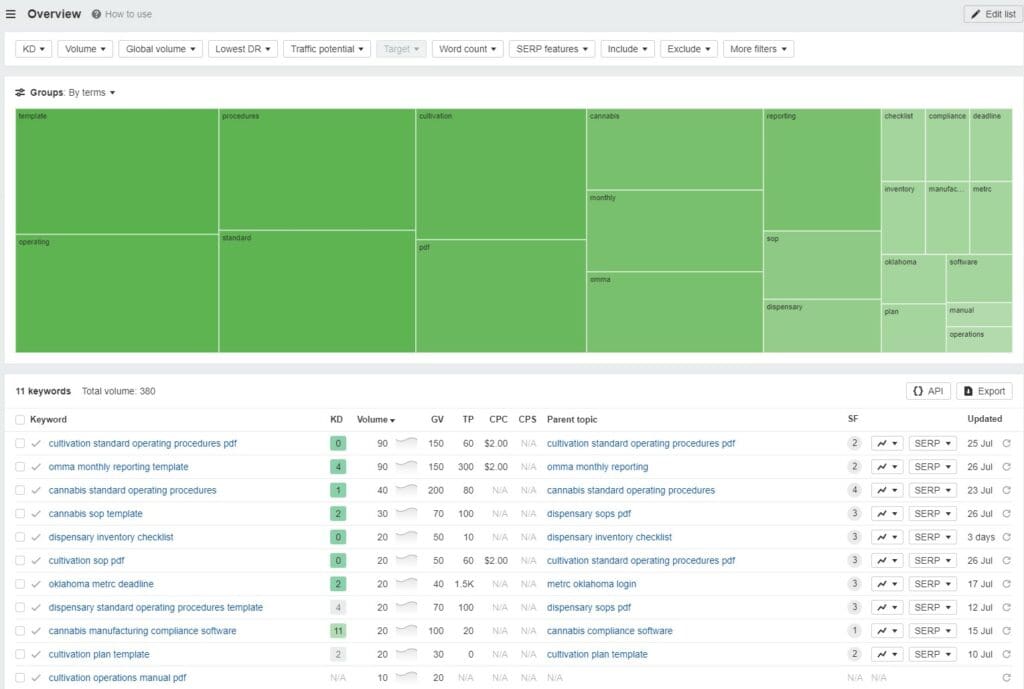
Recognize the knowledge your sales team holds
Nobody understands what your qualified prospects need better than your sales team. They’re a wealth of information about what motivates them to make contact with your brand. More importantly, they know what factors tend to carry the most influence in getting them signed. Really take the time to sit down with them and get as much info as you can about the typical new client journey.As an example, one of our clients recently mentioned “It’s usually about 20 minutes into the discovery call that the client has that ‘aha’ moment… ‘[product name] takes care of all of that for me automatically?!’”Rather than waiting for the client to comb through the website, reach out, agree to a discovery call and taking 20 minutes of discussion to recognize the true value, tell them up front! Clearly that ‘aha’ moment is the one that convinces them the platform is worth it so make it obvious to them in the first 1/3rd of your page content. Thats customer-centric content at its finest.“Reduce your daily compliance time by 80%” is a far more powerful brand introduction than “the best cannabis erp platform” or “the cheapest cannabis software”. The first one directly offers a solution to their biggest pain point while the others are just throwing out generic sales terms.Getting your sales and marketing teams to truly align is a notorious challenge. One of the best ways to achieve this is by eliminating the ‘marketing’ vs ‘sales’ silos and creating a cohesive ‘revenue team’, as Impact puts it. Here’s what they have to say about creating that revenue team — be sure to check out their whole article, it will prove valuable if you choose to implement it.“This is a team made up of the main players from sales and marketing. They get together every two weeks to brainstorm topics based on questions your sales team hears every day. These are questions that:
- et asked all the time.
- Indicate a buyer is far from making a decision.
- Show resistance, doubts, worries, or fears.
- Expose gaps in information necessary for key decision-makers to give the go-ahead.
- With this information, marketing can produce thorough, vetted content to address these questions in a way that builds trust with buyers.”
3. Record the 3-5 most influential elements and prioritize them
Now that you’ve taken the time for this discovery process, you have a host of relevant information — time to turn it into actionable next steps.List the 3-5 most important things your audience is looking for and put them into a priority order as best you can. Thinking about their thought processes, consider which problems they’re trying to solve first, front and center. No fluff or general sales points.As an example pulled from the data above, the problems/solutions they’re looking for are:- Spending too much time every day on staying compliant with industry regulations
- Needing a better solution to handle all the data they have to maintain daily
- Searching for a way to handle their particular type of operation (e.g. grow software, distribution software etc)
4. Implement these elements in a format that’s easy to digest
Now that you have those key points ready to go, it’s time to sit down with your designer and talk implementation. The goal here is to answer their questions in as few words as practical and in a way that makes sense.On a landing page, users don’t read large blocks of text, they’re skimming for information that relates to their needs and they’re trying to do that fast. That’s where a strong designer becomes invaluable.A good use of logical flow (where do I look next?) and visual aids allow you to get your point across without having to write those unwieldy blocks of text. As a SaaS brand you can show them what your product looks like using images, video or even a demo account.Screenshots, videos and relevant graphics draw their eye more than any text and give them so much info in an instant.Here’s a classic example of that from Ahrefs one of the leaders in the SEO SaaS vertical. Immediately below the fold, you see a clear screenshot of what the tool looks like, along with:- Key functionality highlighted on the screenshot
- A link to a page that goes into more detail about each of those features
- The ability to watch a video of the tool in action
 As a comparison, here’s a snippet of Majestic SEO’s home page, a direct competitor to Ahrefs. The difference here is night and day. They might cover very similar information but… are you going to read all that text? I know I didn’t and neither will most of their prospective clients.
As a comparison, here’s a snippet of Majestic SEO’s home page, a direct competitor to Ahrefs. The difference here is night and day. They might cover very similar information but… are you going to read all that text? I know I didn’t and neither will most of their prospective clients.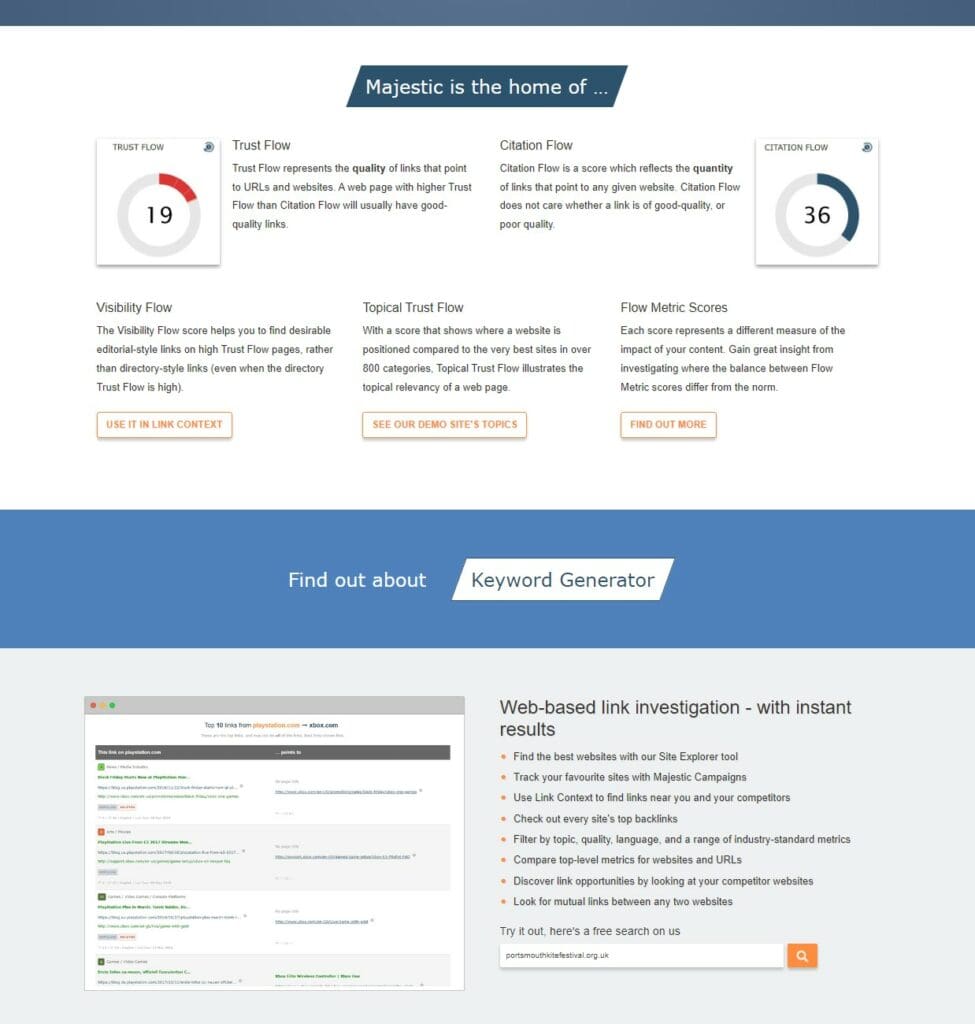
5. Stop cramming. Give larger topics their own page
Some topics just need further explanation to get the full picture don’t fall into the trap of trying to jam all that info for multiple features, all onto one page. No user cares about every facet of your product so don’t torture them by making them trawl through it all.Let’s go back to Ahrefs for an example. They have a lot of features and cover a lot of information on their website. On their home page, they manage this by using a single phrase to tell you what the main ones do, then give you the option to view a dedicated page about that topic.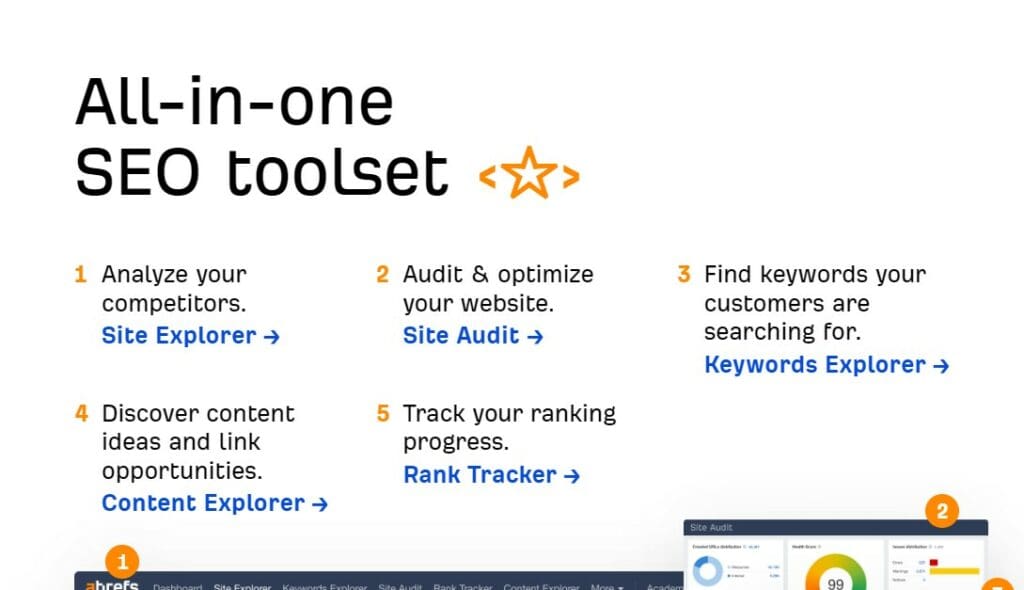
6. Monitor user interactions and adjust accordingly
Websites are never set-and-forget. Run through the above steps, gather and implement that information using your best judgment then monitor the outcome. After a major change, I check in on the metrics daily for the first week to check for any red flags like major dips in traffic, pageviews or conversions. After that, monthly check-ins with the team are the best timeframe. Any shorter than that and you’ll start reacting to standard fluctuations rather than looking at the trends.The two tools I use to monitor this outcome are HotJar and Google Analytics. Analytics offers information around user behavior flow and engagement (pages per user, time on page etc) while HotJar gives you heat maps and screen recordings. By reviewing those recordings, you can see how people are interacting with your site and develop a refined understanding of their journey.7. Check your sales metrics to see what impact it’s had on your bottom lineThe final step is to make sure these changes are having a positive impact on your sales team as well. There’s no single metric that tells the full story, instead you want to look at all the important factors:- MQLs
- SQLs
- New clients

